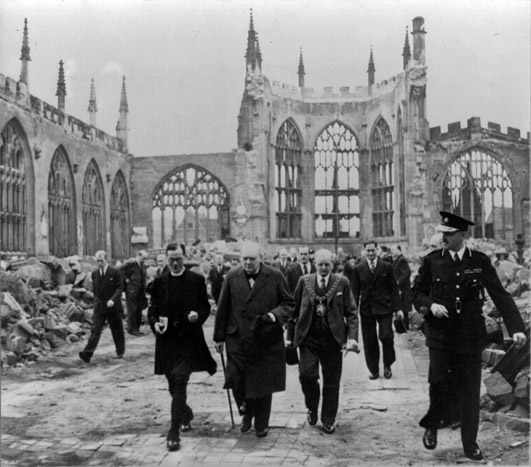Among many other interestings things to read in Rubble: Unearthing the History of Demolition by Jeff Byles – who will be speaking at Postopolis! on Thursday afternoon – is the fact that part of Manhattan is actually constructed from British war ruins.
 [Image: Winston Churchill visits the ruins of Coventry Cathedral, 1942; courtesy of the Library of Congress].
[Image: Winston Churchill visits the ruins of Coventry Cathedral, 1942; courtesy of the Library of Congress].
Toward the end of the book, Byles describes how “[m]ore than 16 million people saw their homes wrecked by bomb destruction during World War II, with more than 4.5 million housing units completely toasted.”
Further, “[w]ith London and Coventy knee-deep in rubble by the fall of 1940, a phalanx of 13,500 troops from the Royal Engineers got busy ripping down war-ravaged structures.”
But what to do with all that rubble…? Byles:
Around that same time, New York’s FDR Drive was being constructed, which ran along the east side of Manhattan. “Much of the landfill on which it is constructed consists of the rubble of buildings destroyed during the Second World War by the Luftwaffe’s blitz on London and Bristol,” the historian Kenneth T. Jackson wrote. “Convoys of ships returning from Great Britain carried the broken masonry in their holds as ballast.”
When you’re driving around on the FDR, in other words – or, for that matter, when you’re simply looking out over the east side of Manhattan – you and your gaze are passing over fragments of British cathedrals and London housing stock, flagstones quarried from Yorkshire, the shattered doorframes and lintels – and eaves, and vaults, and partition walls, and bedroom floors – of whole towns, pieces of Slough and Swindon perhaps, embedded now in asphalt, constituting what would otherwise have passed for bedrock.
Down in the foundations of the city are other cities.
(Elsewhere: We learn that the British coast has become geologically French, further complicated our future sense of geological belonging – raising the interesting possibility that one can exist in a state of geological alienation… Psychoanalysts will have a field day. [via]).
I really like your closing line. I like the idea of cities founded on cities, and cities made of bits of other cities. Oh, and on your recommendation, I ordered Jeff Byles’ book. Thank you.
Field day…
Was that a Freudian slip?
well, a little london highway fill does not really make up for the 8,000 souls the brits barbarically made suffer and then murdered just across the east river from the fdr in wallabout bay does it?
http://www.newsday.com/community/guide/lihistory/ny-history-hs425a,0,6698945.story
Wow.
Presumably much of that rubble is roughly traceable to its times and regions of origin, via architectural detailing, geological composition, etc.
That should cause future archaeologists quite a bit of head-scratching.
This reminds me of a story a friend in London told about apartment hunting. Looking at a map of WC1 or so, they asked the broker, “My god, what sor to f lunatic laid out the streets like that?1”
He responded, “Hitler”. As rebuilding streets tookplace where everthere was a scarcity of rubble.
Much of The United Nations building’s foundation is rubble from London after The Blitz – WW 2 American heavy cargo ships having sailed and off loaded thousands of tons of heavy equipment (tanks, trucks and associated) needed ballast for their return voyage to The Port Of NYC – take The Circle Line around Manhattan, the guide will undoubtedly make certain to point this out “See that rip rock? That’s London”
Most of the rubble was from Liverpool, the main convoy port.